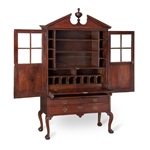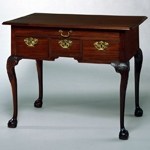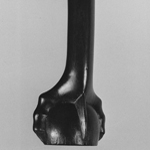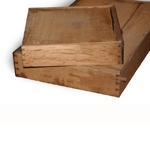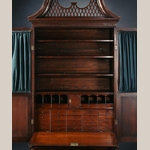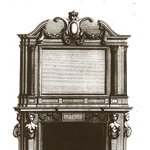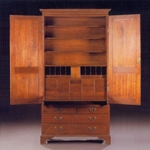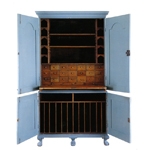Rarely in the course of studying American cultural history do historians encounter an unfamiliar furniture form, especially one of great scale or stature. When such incidences occur, they are ripe with potential to significantly expand an understanding of the material world inhabited by our ancestors. Over the last decade, the discovery of several ambitiously designed desks from Tidewater Virginia presents a valuable opportunity to explore the origins and usage of a distinct form of desk—one that may strengthen our insights into the impact of Irish and Scottish culture in the coastal South during the colonial period.
Only one of these desks has previously been published—a painted pine example made about 1750 by Scottish emigre cabinetmaker Robert Walker of King George County, Virginia and now in the collection of George Washington’s Mount Vernon (Fig. 1). This is the earliest of the form currently recognized from colonial Virginia.[1] A 1750-60 Norfolk, Virginia, example that appeared discreetly in the marketplace in 2011 introduces a previously unrecognized variant of the form that stands on cabriole legs with claw feet and is capped by a raking pediment (Fig. 2). Two further examples (Figs. 3 and 4), both made by an anonymous Virginia artisan during the early 1770s, coincidentally appeared in the marketplace in quick succession in 2001 and 2002, respectively, and then disappeared quietly into private southern collections. At present, taken together, these four desks are the only recorded survivors of a form that may have been introduced to eastern Virginia by Scottish and/or Irish settlers, and is otherwise unknown to survive elsewhere from colonial America.
Function, Evolution and Nomenclature
These four imposing case pieces differ in obvious ways from the standard “slant front” desk that dominated British-American furniture design in the mid eighteenth century. They resemble architecture as much as furniture, with their function as desks concealed completely from view when the doors are closed. One can only surmise the origin of the design; nonetheless, a cursory investigation into the history of British desks during the late seventeenth and early eighteenth centuries provides tantalizing evidence to suggest the logical evolution of their form from an earlier style.
Furniture forms associated with writing—and the storage of writing materials—proliferated in the second half of the seventeenth century. In Britain, King William III of Orange (1650-1702), and his wife Mary II (1662-1694), introduced Renaissance trends that swept aside many of Britain’s medieval ways. The king designated a room at Hampton Court Palace as his “writing cabinet” or “writing closet.” Among its furnishings was a Chinese lacquered cabinet intended to store a multitude of paraphernalia for writing, as well as an elaborate English Baroque table specifically referred to as a “writing table.”[2]
In the late seventeenth century, a furniture form that combined the storage of writing paraphernalia and provided a writing surface found a great following in Britain. The writing cabinet usually had a dovetailed, box-shaped case with a vertical fallboard that was hinged along the lower edge of the front and, when lowered, served as the writing surface. The cabinet usually sat upon a turned base or a chest of drawers—or in expensive examples, upon a carved stand—and had an interior that contained a variety of features that facilitated writing and reading—including pigeonholes, drawers, shelves and occasionally a central prospect door (Fig. 5). If the owner wanted to lock the cabinet when not using it, he or she needed to move the paper, inkstand, and related writing accoutrements to the interior before raising the fallboard and turning the key.
The English generally referred to such a desk as an “escrutoire” in the late seventeenth and early eighteenth century. The Oxford English Dictionary notes that the English word “escrutoire” was derived from the French escritoire, or “writing cabinet,” and records its first use in Britain in 1665.[3] On the finest examples, a pair of doors concealed the interior fallboard, but on less-expensive versions a cabinetmaker sometimes emulated this convention by applying a molding down the fallboard’s center front, and then adding a false keyhole and false hinges at its juncture to the case sides: When closed, the fallboard’s façade suggested a pair of doors without the expense of constructing actual doors.[4]
Such early escrutoire existed contemporaneously with “desks,” a name used to designate a piece of furniture for writing and storage that appears to have differed most obviously in having a slanted front. Although a desk was generally not as expensive as an escrutoire, in one respect it was much more practical—the slanted front provided interior storage space for writing implements and paper, and did not require the user to completely clear the work surface before closing the fallboard. The desk’s lower cost and greater practicality may account for the form’s longevity: After 1740, the straight-front escrutoire generally fell from favor, but the desk retained great popularity throughout Britain.
In Virginia, the word “escrutoire” was spelled in a number of ways, including “scrutoire,” “scrutore,” “scritore,” and “scripstore.” Other variants likely exist, but for the sake of consistency “scrutoire” will be the preferred spelling here. MESDA’s Craftsman Database documents a 1673 reference for the scrutoire—both the term and the furniture form—in a Norfolk County, Virginia legal dispute: Jonathan Handson sued local joiner James Browne for failing to complete a “case of drawers of scritore” as stipulated by their written contractual agreement.[5]
That this Virginia reference to the term “scrutoire” appeared in 1673—a short eight years after The Oxford English Dictionary’s recorded its first use in England—has potential implications about the origin of this new furniture form and dissemination of the vocabulary that described it. Indeed, if the 1673 reference cited from Virginia reflected a term that had been in use for several years in the colony, then it seems plausible to suggest that the word might not have entered the language through the literati of early London. Instead, it may have done so through Ireland, where a predominantly Catholic population with an affinity for French culture could have first adopted the word. If this is the case, the term may well have migrated from Catholic Ireland northward to the feisty protestant Scots-Irish and Scots—and thence to America—before entering the language of French-aversive English culture.
The four desks that provide the focus of this study represent an evolution of the early escrutoire. All four originated in Tidewater Virginia between 1745 and 1775. Beyond this, most aspects related to the four—including the identity of those who owned them, specifically where the form was used, and how they functioned—remain open to further investigation. Nonetheless, preliminary evidence provides tantalizing suggestions concerning the form’s history and its adoption in the early Tidewater. Recent investigations strongly indicate that the closest precedents hailed from Ireland and Scotland, where related forms with a small group of desks having writing interiors concealed behind bookcase doors are known today by a number of terms, including “shelved closet,” “bureau cabinet,” and “estate desk.”[6] Unfortunately, at present, there seems to be little published research concerning the evolution of the form in either of those countries, or clarity concerning the original nomenclature associated with it.[7] Curators and researchers at George Mason’s Gunston Hall, near Lorton, Virginia, have analyzed hundreds of upper-class, wealthy Chesapeake inventories for an intensive “Room Use Study” that illumines our understanding of early Chesapeake interiors and home life. The project identified representative furniture forms, attempted to determine their placement in the home, and considered their functions in daily life. The inventory referenced numerous desks, desks and bookcases, and scrutoire, but did not mention any other furniture form called by any name that might be construed as a writing cabinet. However, desks and scrutoire sometimes appeared in an inventory side by side, or in adjoining rooms, indicating that the inventory-takers distinguished the forms from one another. Equally important, after the 1740s references to scrutoire dropped off significantly: By mid-century the majority of scrutoire were referenced as “old,” and usually had a value of £1 or less. This strongly suggests that the form, like the word, was becoming obsolete in most households.[8]
The Scrutoire in Ireland, Scotland, and Virginia
Despite its fall from favor in England in the middle of the eighteenth century, the scrutoire form retained a degree of popularity in Ireland, and likely in Scotland, where joiners and cabinetmakers continued to adapt the form to suit evolving tastes. In their recent book, Irish Furniture, scholars Desmond Fitzgerald and James Peill illustrate several pieces related to these Virginia writing cabinets. One consists of a chest surmounted by a pedimented writing cabinet, with long doors that open to reveal an interior fallboard and a fully fitted writing compartment (see Figs. 6 and 7). Another consists of a fitted cabinet on stand with Marlboro legs and a pendant in the skirt (see Figs. 8 and 9). The fallboard and writing compartment of both pieces are concealed behind a pair of cabinet doors.[9]
Although Gunston Hall’s “Room Use Study” included but a small number of total Chesapeake inventories, it nonetheless indicates the wider trend in which desks displaced old fashioned writing cabinets or scrutoire. However, it also provides evidence to suggest that the term scrutoire—and perhaps the form associated with it—enjoyed a slight revival in the mid eighteenth century. Indeed, in contrast to the majority of “old scrutoire” that appear in inventories with very low values, several scrutoire that appear in inventories during the third quarter of the century were quite valuable, suggesting not only that production of scrutoire continued, but possibly that the from evolved in decoration and form. Most importantly, the majority of references are associated with families of Irish or Scottish descent, highlighting the form’s popularity among non-English colonists. However, the evidence provided by the Gunston Hall study has several caveats that must be noted: Only one eastern Virginia household inventory indicated this trend. However, so too did several in Maryland, which is not totally unexpected in light of that colony’s large Irish population—though, at present, no Maryland examples of this distinctive form have been documented.[10]
Although no surviving scrutoire from Maryland is yet identified, it merits mention that at least one Annapolis artisan advertised the form after the mid eighteenth century: In 1754, cabinetmaker and turner Gamaliel Butler advised the public that he “engaged very good Workmen, in the CABINET-WAY” and offered “all Sorts of Cabinet-Work” in a variety of forms that included “escrutoires” as well as “desks.”[11]
Several Virginia and Maryland inventory references suggest that the new scrutoire of the second half of the eighteenth century evolved in form from the “old” ones that appeared in inventories with very modest values. For example, the 1768 estate inventory of Major Traverse Tarpley of Richmond County, Virginia, included an “escrutoire” valued at £7.[12] Likewise, the Gunston Hall researchers referenced a “Neat Scrutoir or Cabinet Mahogany £26.11.4” recorded in the estate of widow Henrietta Maria Dulany, a lady of Irish descent who lived in Anne Arundel County, Maryland, where she had used it in the “Bed Roome… .” The scrutoire’s high value suggests that it was not only comparatively new, but also highly adorned.[13] One of the later references to scrutoire on file, the 1794 estate of Frank Luke of Prince George’s County, Maryland, recorded “1 old Escrutoire with a glass door” valued at the old-fashioned price £2.5.0. It was located in “Mrs. Luke’s Room”.[14]
A Norfolk Variation
In the mid 1990s, Ronald L. Hurst of Colonial Williamsburg demonstrated Ireland’s strong impact upon furniture made in the Rappahannock River Basin of Virginia, and set the stage for a wider discussion of Ireland’s influence upon the coastal South. The evolution of the scrutoire in mid-eighteenth century Virginia reinforces how Irish and Scottish culture adapted the earlier form and made it a distinctive regional form in the American South.[15]
The scrutoire presented in Figure 2 possesses cabriole legs with prominent knee flanges, knee returns with pronounced scrolls, and boldly carved claw feet (see Figs. 10 and 11)—all of which combine to suggest a maker who learned his craft in the late 1730s or 1740s. The cabinetmaker who crafted this scrutoire remains anonymous. He could have been born in Virginia, but he just as likely could have immigrated to the colony about mid-century—and if so, may have hailed from Ireland, where similarly styled legs and knees appear with some frequency on mid-century furniture.[16]
It is important when discussing this furniture form, to understand that, like most of the Irish and Scottish settlers in colonial Virginia, the artisan who made this cabinet was probably Protestant. In contrast to nearby Maryland, where Catholic Irish were welcomed by a succession of Lords Baltimore, Virginia’s well-established Anglican hierarchy was not accepting of Catholic emigrants, and few chose to live in the colony. Most Irish who came to Virginia were Scots-Irish from the north of that country, and like most émigrés who came to Virginia from Scotland, were Protestants: These consisted principally of Presbyterians, but also included a number of Episcopalians, and smaller numbers of Quakers.[17]
The scrutoire in Figure 2 has structural and stylistic details that strongly suggest that the anonymous cabinetmaker who made the piece lived along the banks of the lower James River, most likely in the city of Norfolk. Several of the scrutoire’s defining features are characteristic of that urban center, including the partially glazed doors and the distinctively shaped opening of the pitch or “raking” pediment. The latter is virtually identical to that on a Norfolk corner cupboard or “bowfat”—another term that Virginians appear to have adopted from the French (Fig. 12). This cupboard has several notable features, including Chinese mullions in an octagon-and-square configuration that also appears on another Virginia scrutoire (Fig. 3). While the scrutoire in Figure 3 differs significantly in exterior details, it has a fitted interior that shares many features with the scrutoire in Figure 2, including adjustable shelves, pigeon holes, small drawers, and a central prospect compartment (Fig. 13). The scrutoire presented in Figure 3 will be discussed in greater detail momentarily.[18]
This scrutoire (Fig. 2) is tied to a large group of formal carved furniture from the Chesapeake. Each claw foot has a rear talon that differs from the other three talons. This rear talon has a knife-blade along the inner edge, instead of rounded edges (see Fig. 11). This feature links the piece conceptually to a sizable group of claw-footed tables that are traditionally attributed to Edenton, North Carolina—located only 75 miles away from Norfolk (see Figs. 14 and 15).[19] Furthermore, this scrutoire has quartered oak drawer liners and yellow pine drawer bottoms that are set into grooves on three sides and then nailed across the back (see Fig. 16)—drawer construction, but more importantly the use of oak drawer liners and yellow pine bottoms, that parallels those employed on the Edenton table group.
The continuity between the earliest and latest pieces of the larger group of claw-footed furniture traditionally attributed to Edenton, together with the early pediment’s relationship to that on the later Norfolk corner cupboard (Fig. 12), indicate that these pieces span a quarter century or more of production, and as such represent inter-generational traditions. Equally important, the parallels between the two groups do not warrant the scrutoire’s attribution to Edenton, which had approximately 500 residents in 1760, but instead prompts consideration that the larger carved table group could have originated in the cosmopolitan city of Norfolk, with a population of approximately 5,000 inhabitants at the time. That possibility is further strengthened by documentary evidence, for early Norfolk possessed documented carvers who can be traced from the mid-eighteenth century onward. MESDA has documented two carvers who merit mention at this juncture of the discussion: Henry Wells (I) worked in Portsmouth as early as 1753—a date that realistically corresponds with the earliest of the scrutoire—and Henry Wells (II) continued to practice the carver’s trade in Norfolk as late as 1814. Although inadequate evidence exists to credit either artisan for making any furniture in the larger group, the continuity of tradition suggests that Norfolk potentially supported an unbroken carving tradition from the mid eighteenth century onward.[20]
Other Virginia Scrutoire
The scrutoire with a pierced pediment and Chinese mullions in the doors (Fig. 3) has an interior carefully outfitted with shelves, drawers, and pigeonholes, though it is further enhanced with a prospect door (Fig. 17). The half-paneled bookcase doors provide a noteworthy parallel to those on the scrutoire in (Fig. 2). And the bold feet that scroll inward at the base also tie it clearly to other colonial Norfolk work with those features. In style, it reflects a transition, for the unusual pierced fretwork in the cornice frieze and diamond piercings of the pediment echo mid-eighteenth-century rococo tastes. In contrast, the bold scale of the pediment and the unusual carved lobes at the tip of each scroll—which have no precedent in America—harken to earlier baroque tastes. The lobes appear to represent the cabinetmaker’s interpretation of a design introduced in the seventeenth century by the English renaissance architect Inigo Jones, and subsequently in a mid-eighteenth century engraving of a chimneypiece illustrated in John Vardy’s publication “Some Designs of Mr. Inigo Jones and Mr. Wm. Kent (London 1744) (Fig. 18).
Although the maker and the owner of the scrutoire in Figure 3 are unknown, the date “1773” inscribed in white chalk on the reverse of the upper backboards likely signifies the date of production, which is probably the latest in the group. The interior of the upper backboards also bear two initials branded in block Roman letters, but since they are not horizontally oriented, rather than vertically, they could be interpreted as either “WW” or “MM.” Based upon eighteenth- and early-nineteenth-century precedents, in which owners branded household furniture as well as livestock, these probably represent the owner’s initials. Unfortunately, at present, the initials cannot be associated with a specific individual, yet leave open the possibility of further discovery, and especially so if another piece bearing the same marks and possessing a history surfaces in a regional collection or the marketplace.
Construction details of this desk further underscore a Norfolk attribution. For example, the ogee feet are supported with composite blocking characteristic of formal furniture made in early Norfolk and Williamsburg cabinet shops. Furthermore, the case has full-bottom, full-depth dustboards between the drawers, a characteristic of colonial furniture made along the James River from Norfolk westward to Williamsburg and beyond.[21]
A second scrutoire made by this same maker is also recorded (Fig. 4). It is the only one among these four without carved details, except the simply shaped panels in the upper doors. This was a simpler and therefore less-expensive object, for it lacks a pediment and has panels in the doors rather than complex Chinese mullions. However, these details expand the otherwise limited vocabulary of ornament associated with this shop, and may assist in identifying other pieces by the same maker, or uncovering his identity and specific place of work. Interestingly, the interior drawers are marked with letters of the alphabet, indicating that in addition to its role as a place for writing, it also served as a place for filing old correspondence or bills (Fig. 19).[22]
The fourth Virginia writing cabinet (Fig. 1 and Fig. 20) dates circa 1750, and as such, is the earliest of the form currently known from Virginia. Scottish émigré cabinetmaker Robert Walker (circa 1710-1775) produced the piece that descended in the Jett family, who were also émigré’s from Scotland. Thomas Jett (d. 1785) was a prominent merchant based in Leedstown on the Rappahannock River and a close associate of Robert Walker.[23] The lower case has a series of twelve slots for ledgers, and suggests that his business was extensive. The ledger slots, together with a case of twenty-four yellow pine drawers, strongly suggest that the piece contained records for a large and prosperous commercial establishment.
Robert Walker had an older brother, William Walker (circa 1705-1750), who was likewise a house and cabinet joiner from Scotland. Although no furniture can be attributed with certainty to William, he merits an introduction because he first appeared in Virginia records working for the Dublin-born Irishman John Mercer of Marlborough Plantation, in Stafford County, Virginia. Equally significant, Mercer’s first ledger entry for William Walker in 1730 records that he repaired a “scrutore.” That such a reference appears in conjunction with a Scottish-born cabinetmaker and a consumer of Irish heritage is important. Their relationship reinforces the form’s association with Scottish and Irish culture in early Virginia, and strongly suggests that—like the Irish examples illustrated earlier in this article—similar examples were produced in Scotland, as well.[24]
Before offering several conclusions about the survival of the scrutoire in Virginia and Maryland, it is instructive to make an observation about a similar evolution of furniture in Pennsylvania. Just as mid-century Virginians updated the scrutoire form by adding pediments on the most fashionable examples, enclosing the fallboards behind paneled or glazed doors, or placing lower cases upon cabriole legs, so, too, did Pennsylvania artisans add pediments and elaborate carving above the flat-top high chest of drawers—despite the fact that high chests generally fell from favor in mid-eighteenth century England, giving way to the up-to-date clothespress. In short, the evolution of two very different furniture forms in different regions of America seems nonetheless to reflect a similar social process at work.[25]
Conclusion
Despite the rarity of known surviving scrutoire in the American South at present, none have been identified from the Northeast, where many cabinetmakers and consumers of Scottish and Irish descent likewise lived. One might conclude that the South’s strong economic ties to Britain nurtured loyalty to British furniture forms, and that southern culture continued that tradition when such inclinations had long since fallen by the wayside in the North. Yet that simplistic conclusion is insufficient to explain the potentially complex cultural meaning of the form, or its contribution in interpreting the varied layers of Virginia’s colonial culture. Several points merit discussion. First, that the difficulty of documenting the scrutoire form in Chesapeake households may stem from its intended use in counting houses and storerooms. Certainly, the survival of the three examples that originated in the environs of Norfolk—the colonial Chesapeake’s largest port and its principal link to business abroad—could support such a conclusion. Furthermore, the Chesapeake’s prodigious foreign trade in agricultural produce, fueled in large part by sales to Scottish tobacco and wheat factors, adds credibility to that interpretation. And, finally, the Scottish influence of the form is made more understandable if one thinks of the unquenchable thirst for luxury goods by aristocratic Virginians—such as the the Mercer family that employed William Walker—and the simple fact that the vast majority of those goods came from Scottish-owned stores. Successful Scottish merchant families, such as the Allasons and the Glassfords, had numerous stores throughout Maryland and Virginia. This observation certainly seems pertinent.[26]
It is still not clear what term Virginians of the period used to reference these distinctive case pieces, though the word “scrutoire” would seem a logical conclusion. That acknowledged, the scarcity of the term in mid-century Virginia inventories may mean that such pieces simply masquerade behind the terms “desk” or “cabinet.” Nonetheless, it is essential to note that the majority of these desks had comparatively few large drawers that might be used for storing domestic goods, and almost as few shelves for books. Instead, they had a plethora of pigeonholes, small drawers, and ledger slots—features that would seem to connote a purpose focused as strongly on the filing of correspondence and the recording of business transactions, as upon writing. In light of this, it is also essential to suggest that the term “counting room desk,” which appears from time to time in commercial correspondence and inventories, may have referenced this form—though none of the references yet encountered seem to have possessed sufficient value in the mid eighteenth century to merit consideration of a piece that equals the stature of the finer examples discussed here.
One must also consider another aspect of coastal Virginia culture when debating the function of these scrutoire. It merits noting that the free men and women in colonial Virginia were predominantly of English heritage, and that the English not only held the reins of political power but also the vast majority of land. However, the comparatively small number of Scottish and Irish settlers played a disproportionately large role as merchants and commercial factors for the brokering of tobacco and wheat. Thomas Jefferson’s friend and neighbor, Peachy Gilmer (1779-1836)—a Virginian of Scottish descent—wrote a biography in which he recalled the character of life in early Virginia, and emphasized: “The Scotch were the merchants, and the Irish, the pedlars [sic] of that age.”[27] Whether these scrutoire appeared exclusively in commercial establishments owned by Scottish and Irish merchants in Virginia or also in their homes seems a logical question to pose, as well.
The four Virginia scrutoire discussed in this study represent a comparatively small group when they are measured next to the plethora of slant front desks that survive from the early Chesapeake. Nonetheless, they merit recognition for the bold contrast that they provide to the “neat and plain” furniture that dominated domestic interiors of colonial Virginia, for their distinctive individuality, and for their possible indebtedness to Irish and/or Scottish culture and prototypes. Further research will hopefully identify additional examples, as well as illuminate their function and identify the terminology associated with the form.
Indeed, it is intriguing that Scottish and Irish settlers of the Chesapeake may have continued to use a distinctive furniture form that was indigenous to their cultures, and to retain the French term “scrutoire” to describe it, long after the form and the word had fallen from favor among their English compatriots. As the date “1773” inscribed on one scrutoire (Fig. 3) suggests, Scottish and Irish settlers may have gone to great lengths to produce these bold baroque pieces, and to maintain their cultural identity separate from the English powerbrokers, nearly until the end of the colonial era. To what degree such stylistic and linguistic distinctions were meant simply to foster kinship among family and commonality with others of similar heritage merits further exploration. Equally compelling, perhaps these unconventional furnishings will provide hints of ways in which distinct Irish and Scottish cultures, united in the New World beneath Britain’s unrivaled military and political power, coexisted with the dominant English in the colonial Chesapeake.
Sumpter Priddy is director of Sumpter Priddy III, Inc. in Alexandria, Virginia and a noted author and lecturer on American decorative arts and culture. He can be reached at [email protected].[1] Robert Leath, “William and Robert Walker and the ‘Ne Plus Ultra’: Scottish Design and Colonial Virginia Furniture, 1730-1775” in American Furniture (Milwaukee: Chipstone Foundation, 2006), pp.86-87, figs. 49-50.
[2] Artist Richard Cattermole recorded the interior of the writing closet with furniture in place in an 1819 watercolor for W. H. Pyne, The Royal Residences (London: 1819). For further information on Hampton Court Palace see J. W. Nordholt, J. G. Van Gelder, and A. W. Vliegenthart, William and Mary and their House (New York: Pierpont Morgan Library, 1979).
[3] Oxford English Dictionary, see “scrutoire” and “escrutoire.”
[4] See John Gloag, A Short Dictionary of Furniture Containing 1767 terms used in Britain and American (New York, Holt, Rinehart and Winston, 1965); the definition for “scrutoire,” which illustrates a scrutoire having a fallboard that, when closed, has a façade falsely suggesting two doors that opened outward.
[5] Reference to “my Scrutore” appears in “The last will and testament of Francis Epes,” in Henrico County, VA, Deeds, Wills, no. 2, part 1, 1725-1737, p. 459, entered Dec. 1734. The reference to “1 Scripstore and the Ornaments that stand thereon” comes from “An Appraisement of the estate of John Woodley, deceased, in Isle of Wight County, VA, Wills, Inventories and Appraisements, vol. 3, 1726-1734, p. 273, 26 Sept 1726. The earliest reference recorded in Virginia, and possibly in America, is spelled “scritore” and appears in Jonathan Handson, plaintiff vs. joiner James Browne, defendant, in Norfolk County, VA, Wills & Deeds, Book E, 1666-1675, p. 109, 16 April 1674.” The judge cites violation of an agreement “dated the 4th December 1673” and appointed court representatives Capt. John Hatton and William Dayves to “Repayre to the house of Mr. Enoch Tart, and there view said scritore and give in their Reports to the next Orphants Court.” Other variants exist, as well.
[6] Inventory takers may have also identified scrutoire as “Lady’s Cabinets” or “Lady’s Closets,” a Scottish cabinet-on-chest form that usually included a single-door upper chest that enclosed small drawers, pigeon holes, and/or shelves over a chest of drawers. Tara Chicirda, “Curious Cabinets,” 2005 MESDA Summer Institute on Early Southern Material Culture & Decorative Arts, Winston-Salem, NC. See MESDA’s example (Acc. 3522): http://mesda.org/collections/furniture_sprite/mesda_cabinetonchest_sprite.html.
[7] Reference to the form as a “shelved closet” cited from an e-mail correspondence between Ian Gow, Curator of the Scottish National Trust, to Betty Leviner, Historical Consultant, Williamsburg, VA, 10 December 2010. The author is grateful to Ms. Leviner for her assistance. The Knight of Glin and Piell reference a chest surmounted with a bookcase having a fitted desk interior as a “bureau cabinet” or as a “cabinet” in their book Irish Furniture (New Haven, CT: Yale University Press, The Paul Mellon Center for the Studies in British Art, 2007), figs. 57-58 [p. 55]). They also reference a writing table surmounted with a bookcase having a writing interior and ledger slots as an “estate cabinet”(cat. 189 [pp. 250-251]).
[8] One of the most elaborate pieces recorded in the Gunston Hall study was a “mahogany desk and bookcase [with a] Looking Glass Front,” see Inventory and Appraisement of the Estate of Benjamin Fendall, 15 July 1766, Charles County, Maryland, Register of Wills (Inventories) 1766-1773, fol. 1-11, (microfilm CR 39-592-1); the desk and bookcase subsequently appeared in an advertisement of the sale of his household goods (“To be Sold pursuant to the last will . . .” Maryland Gazette, Annapolis, MD, 17 May 1764). Courtesy of the Gunston Hall “Room Use Study”: available online (accessed 27 February 2012) www.gunstonhall.org/mansion/room_use_study/furniture.html.
[9] See The Knight of Glin and James Peill, Irish Furniture, figs. 57-59 (p. 55). The first two images depict Lady Louisa Conolly’s circa 1760 “bureau cabinet” at Castletown, Co. Kildare, Ireland; the third depicts a “mahogany cabinet” made circa 1760 for William Annesley, first Viscount Glenawly, Castlewellan, County Down, Ireland; and the fourth, a mahogany “estate cabinet” without a history, now in the archives of Glin Castle. At present, the author is not aware of Scottish parallels to the Irish scrutoire cited above, but they likely exist. Ian Gow, Curator of the National Trust of Scotland, recently viewed images of the Virginia scrutoire illustrated in Figure 2 and observed that three houses under the National Trust’s patronage—Newhailes, Dun, and Geilston—contain mid-eighteenth-century “closets” similar in form to the Virginia examples, though each lacks an interior fallboard.
[10] An “old scrutoire £1” appears in the “Inventory of the estate of John Fitzhugh,” taken 15 December 1809, entered 8 January 1810, Stafford County, Virginia, Deed Book AA (1809-1811), p. 19-21. Courtesy of the Gunston Hall “Room Use Study”: available online (accessed 27 February 2012) www.gunstonhall.org/mansion/room_use_study/furniture.html.
[11] Advertisement of Gamaliel Butler, Maryland Gazette, Annapolis, MD, 4 April 1747. Butler is often an Irish or Scottish surname.
[12] Richmond County, VA, Will Book 7, 1767-1787, pp. 13-16.
[13] “Inventory of the estate of Henrietta Maria Dulany,” taken 11 November 1766, entered May 16, 1768, in Anne Arundel County, MD, Prerogative Court Inventories, Libra 961, fol. 138-151.
[14] “An Inventory of the Goods & Chattels of Frank Luke, late of Prince Georges County, deceased,” Prince Georges County, Maryland Inventories 1790-1795, recorded 7 October 1794. The estate also contained “1 old Walnut Desk” valued at £0.15.0.
[15] For further information, see Ronald L. Hurst, “Irish Influences on Cabinetmaking in Virginia’s Rappahannock River Basin,” in American Furniture (Hanover, NH and London: University Press of New England, 1997), pp. 170-195.
[16] For examples of related carved legs with tapered flanges on the knees and scrolled knee returns on chairs made circa 1730 for the Fifth Earl of Antrim and used at Ballymagarry, County Antrim, Ireland, and on a circa 1750 mahogany chair, see The Knight of Glin and James Piell, Irish Furniture, fig. 87 (p. 73) and cat. 10 (p. 207).
[17] Further insights into Protestant settlement in colonial Virginia, and limitations imposed on Catholics, can be found in Samuel S. Hill, Charles H. Lippy, and Charles Reagan Wilon, eds., Encyclopedia of Religion in the South (Macon, GA: Mercer University Press, 2005).
[18] For further information concerning adoption of the term “Bowfat,” and that form’s use in Virginia, see Betty Leviner, “Rosewell Revisted,” Journal of Early Southern Decorative Arts, vol. 29, no. 2 (November 1992): 56, n.72. Available online (accessed 27 February 2012): http://www.archive.org/details/journalofearlyso1921993muse.
[19] John Bivins, Jr., Furniture of Coastal North Carolina, 1700-1820 (Winston-Salem, NC: Museum of Early Southern Decorative Arts, 1988), 155-167.
[20] It should also be noted that general outline of each knee return on the respective pieces is closely related, with a pronounced scroll at the lower juncture of the block to the knee.
[21] For images of a Norfolk clothespress with composite feet, made by cabinetmaker John Selden, see Ronald L. Hurst and Jonathan Prown, Southern Furniture, 1680–1830: The Colonial Williamsburg Collection (Williamsburg, VA: Colonial Williamsburg Foundation, in association with Harry N. Abrams, 1997) fig. 121; for a Williamsburg desk and bookcase with full bottom, full-depth dustboards, see Hurst and Prown, fig. 120.3.
[22] The scrutoire in Figure 4, made by the same, unidentified, cabinetmaker, never had a pediment and has two panels in each door. An interior drawer still bears an impression from a mid-twentieth-century rubber stamp that reads “R. Lee Southworth / Antiques / Fredericksburg, VA.” The cabinet descended in the collection of University of Virginia professor Dr. George Weedon and his wife Elizabeth duPont Bayard Weedon of Fredericksburg and Charlottesville, Virginia.
[23] Leath, “William and Robert Walker…,” p. 85-89.
[24] The piece is further discussed in Leath, “William and Robert Walker…,” pp. 85-89, figs. 49-50. John Mercer Ledger Book, 1725-1732, p. 82, bound MSS, D-13, Mercer Museum, Bucks County Historical Society, Doylestown, PA, quoted in Leath, “William and Robert Walker…,” p. 62.
[25] This trend is first recorded in Wallace Gusler, Furniture of Williamsburg and Eastern Virginia (Richmond, VA: Virginia Museum of Fine Arts and the Colonial Williamsburg Foundation, 1978), pp. 21-23.
[26] Harold Gill, personal communication with the author, 11 March 2012. Harold Gill is a noted historian and retired member of the Historic Trades Department at Colonial Williamsburg.
[27] “The Autobiography of Peachy R. Gilmer” in Francis Walker Gilmer, Life and Learning in Jefferson’s Virginia (Richmond, VA: Dietz Press, 1939), p. 370.
© 2012 Museum of Early Southern Decorative Arts

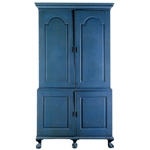
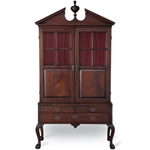
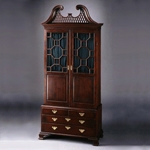
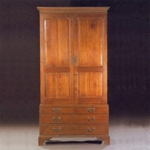
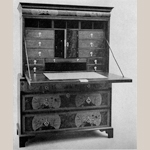
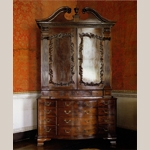
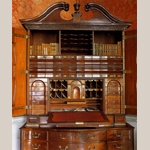
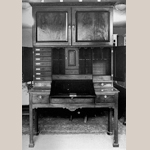
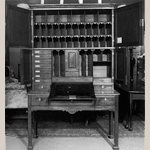
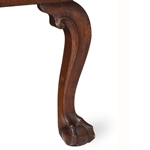
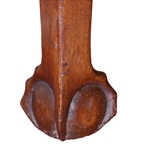
![Fig. 12: Corner cupboard; Norfolk, Virginia; circa 1770. Current location unknown (illustrated in Paul Burroughs, Southern Antiques [Richmond, VA: Garrett and Massie, 1939]).](https://www.mesdajournal.org/wp-content/blogs.dir/23/files/priddy-2012/thumbs/thumbs_priddy-fig-12-thumb.jpg)
